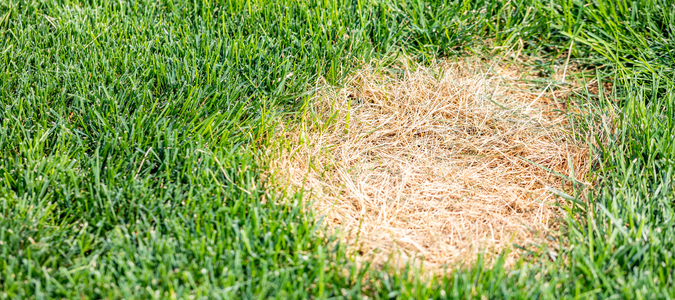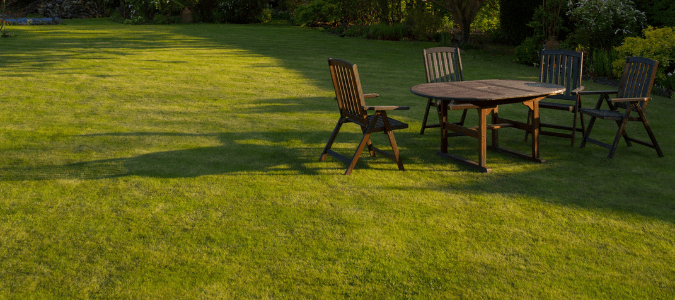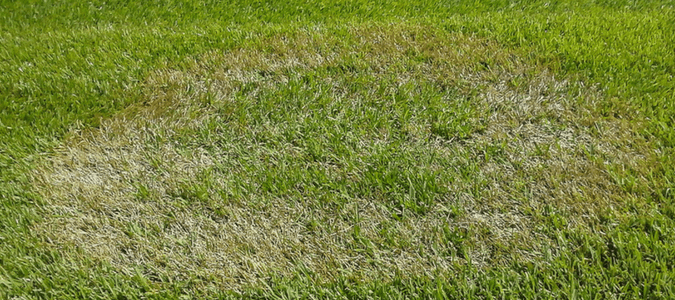A beautiful, healthy lawn is a symbol of pride for many homeowners.
Few things are more disheartening to a committed homeowner than finding discolorations and brown patches on their perfect landscape. It’s especially disappointing when they seem to appear out of the blue.
The sad fact is that disease is a stealthy predator that tends to rear its ugly head overnight, attacking our lawns when we least expect it.
Summer lawn diseases can devastate the most well-cared-for green spaces like a blight.
For homeowners who put in the time and effort to achieve that perfect carpet of green, it’s important to understand what can cause brown patches. And, more importantly, what they can do to repair these problems quickly and prevent them from returning.
What Causes Brown Patches
In reality, there are a lot of things that can kill the grass on a lawn, and not all are disease-related.
The key to spotting and dealing with lawn diseases is to take a very close look at the individual blades of grass to see if they have spots, lesions or other signs of disease or fungus on them.
If they don’t, it’s probably not a lawn disease that’s defacing your beautiful lawn. Here are some common issues that could be to blame instead:
- Damage from dull mower blades. Mowing your lawn with mower blades that are no longer sharp will rip the grass leaves instead of cleanly slicing through them. This can often leave the ends damaged to the point that they can’t recover, so they brown and die.
- Toy structures like swing sets and climbing structures. This is usually not from the toys themselves but due to the increased foot traffic around them. Other items, like hoses, wading pools or the ever-popular “slip-n-slide” are sure to kill your grass if they remain in one spot too long.
- Killing weeds, as strange as it sounds, can be another cause of brown patches on your lawn. When you kill a patch of weeds, they’ve already killed the grass originally growing in that spot. The weeds may die, but they’re likely to leave behind a patch of dead grass when they go.
If you’ve examined your lawn and don’t spot any of these possible causes, you’re likely hosting a lawn disease. Two of the most likely culprits are brown patch fungus and dollar spot.
Brown Patch Fungus
Brown patch fungus is a common lawn disease identified by round brown patches in your grass. This fungus is most prevalent during the hottest summer months.
Brown patch discolorations may range from a few inches to several feet across. It causes previously healthy grass to turn yellow, wilt and brown. It will often grow into irregular shapes and can assimilate with other patches of fungus on your lawn.
These patches often appear surrounded by a grayish “smoke ring” border. Occasionally the grass within the ring will just thin, making it easier to treat and recover.
Most often, however, the grass within the confines of the smoke ring will die.
On close inspections, the affected blades can look dark and shriveled. The blades can also appear water-logged and covered with a white cobweb-ish material. Perennial ryegrass and tall fescue are the grass types most susceptible to brown patch fungus.
Many things can lead to brown patch fungus, like:
- Too much nitrogen
- Extreme hot weather and humidity
- Poor nutrient content in the soil
- Excess thatch
- Compacted soil
Depending on the climate you live in, it can sometimes be difficult to determine the exact cause of this disease. A professional lawn care technician will be able to identify and offer you suggestions to resolve it.
How to Treat Brown Patch Fungus
If your lawn has brown patch fungus, your best bet is to contact a specialist. That said, there are things you can do on your own to try to bring your lawn back to life. Additionally, there are steps you can take to prevent brown patch fungus in the future.
Apply Fungicide
While your lawn may recover on its own, it may be time for some chemical intervention if it doesn’t. Fungal treatments should be left to the professionals. Trained lawn care professionals know exactly which chemicals work best with the kind of grass you have, the treatment frequency and the amount to use.
Properly treated with the right fungicide, you can have noticeable results in just one day.
Fertilize Carefully
An “NPK Value” measures the amount of nitrogen, phosphorus and potassium in the fertilizer. Too much nitrogen is bad for grass, so it’s important to only use fertilizers that have the proper NPK value for your species of grass and climate.
Aerate and Dethatch
Aerating and dethatching encourages water and nutrients to get to the roots of your grass. These necessary nutrients can help keep your grass strong and prevent brown patch.
To aerate your lawn, you’ll need a core aerator or spike aerator, which works by extracting lots of small plugs or “cores” of soil and grass from your lawn. By perforating the lawn like this, you increase airflow.
To dethatch, use a “dethatching rake.” Like any rake, it’s used to gather and remove debris. Dethatching gives the roots of your lawn better access to the oxygen, water and vital nutrients it needs to get and stay healthy.
Know When to Water
Too much water is another possible cause of brown patch. Often, if you water your grass too close to sunset, it doesn’t have time to absorb or evaporate and stays wet all night. This moisture encourages fungal growth as well as destructive pests.
Early morning or mid-afternoon watering can help avoid this problem.
Brown Patch Versus Dollar Spot
Similar to brown patch fungus, dollar spot is an invasive fungal lawn disease. Brown patch appears as brownish-yellow patches that can spread across your lawn. Dollar spot creates small, round clusters around the size of a silver dollar.
Like brown spot, dollar spot fungus thrives in hot, humid environments. These patches are typically yellow, often bordered with a brownish ring.
Dollar spot can spread very quickly and cause a massive amount of damage once it establishes a foothold in your lawn.
Given time, brown patch fungus and dollar spot can decimate the most perfectly kept lawns and green spaces.
If you think that your lawn may be suffering from either of these diseases, or you want to discourage their appearance, contact the pros.
There can be a lot of reasons for occasional lawn discoloration, and lawn fungus diseases are just a few. A professional can determine exactly what’s going on before you spend time, effort and money on a problem you don’t have.
Professionals know exactly how to dethatch, aerate, seed and fertilize your lawn for a lush green yard. Most importantly, they know how to do those things for your specific type of grass.
A lawn care specialist can help you keep your lawn happy, healthy and beautiful all year.
ABC Can Keep Your Lawn Healthy and Green
The best way to prevent any problem with your lawn is to create a lawn care schedule that works best for the lawn type, soil type and sun exposure you have in your yard. Instead of spending your free time trying to determine what will work best for your particular situation, contact ABC Home & Commercial Services. Our lawn care specialists are highly-trained and can provide you with routine lawn care that keeps your lawn free of fungi, pests and other diseases.


